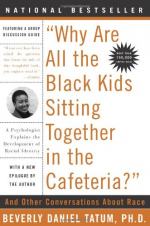
|
| Name: _________________________ | Period: ___________________ |
This quiz consists of 5 multiple choice and 5 short answer questions through Part V, Breaking the Silence, Chapter 10, Embracing a Cross-Racial Dialogue.
Multiple Choice Questions
1. The first African slaves were brought to Jamestown, Virginia in what year?
(a) 1619.
(b) 1702.
(c) 1592.
(d) 1659.
2. Who does the author claim are most guilty of a culture of silence in Part V, Breaking the Silence, Chapter 10, Embracing a Cross-Racial Dialogue?
(a) Asians.
(b) Whites.
(c) Native Americans.
(d) Blacks.
3. What is a way of conceptualizing racial inequalities that focuses as much on the advantages that white people accrue from society as on the disadvantages that people of color experience?
(a) Otherness.
(b) Black oppression.
(c) Racism.
(d) White privelege.
4. When did Erik Erikson die?
(a) 1975.
(b) 1960.
(c) 1980.
(d) 1994.
5. When was Can We Talk About Race?: And Other Conversations in an Era of School Resegregation published?
(a) 1992.
(b) 2004.
(c) 1985.
(d) 2007.
Short Answer Questions
1. In Part II, Understanding Blackness in a White Context, Chapter 3, Tatum writes that she often opens race seminars with adults by asking them about what?
2. What means asserting, resulting from, or characterized by belief in the equality of all people, especially in political, economic, or social life?
3. What university did Tatum attend and describe as a black school that had recently gone co-ed in Part II, Understanding Blackness in a White Context, Chapter 5, Racial Identity in Adulthood?
4. What is the second of three stages of racial consciousness in minority groups delineated in Jean Phinney's model of ethnic identity development?
5. Tatum writes that much of the attraction of the Nation of Islam to black men is that it offers them what?
|
This section contains 288 words (approx. 1 page at 300 words per page) |

|




